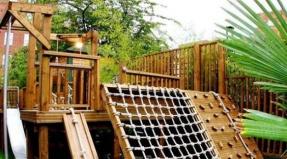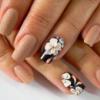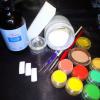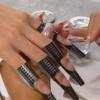UV lamp for bathroom. Ultrasonic bath (Professional ultrasonic mini cleaner). Recovery and care
One of the most ancient methods of treatment with the help of climatotherapy is sun treatment: this technique allows you to get a pronounced positive result, which becomes perfectly noticeable after just a few first applications. The sun's rays, stimulating the protective functions of the skin and the whole body, activate all vital processes in the body, eliminating signs of inflammation and providing the production of vitamin D.
Thanks to this vitamin, it becomes possible to eliminate the insufficiency of the endocrine system to a greater extent, eliminate the negative manifestations of many organic lesions and prevent the aggravation of existing inflammatory processes in the body.
The concept of the method
Being one of the most active healing methods, heliotherapy is easy to perform and can be used both in treatment and for prevention.
Heliotherapy is an almost obligatory component in any resort scheme of therapeutic effects: two types of rays of the solar spectrum provide the most complete positive effect due to diversity. The combination of this method of treatment and other methods of influence allows you to get the most pronounced positive results, eliminating the symptoms of many diseases.
About the benefits and harms of sunbathing, see the video below:
Types of exposure using heliotherapy
Sunlight is divided into two spectrums, which differ both in the type of exposure and in the sensations that arise when using them. The division of the sun's rays into spectra is as follows:
- infrared radiation- a type of radiation that penetrates the skin and leads to the expansion of blood vessels due to their significant expansion, which allows the absorbable effect on various tissues, to eliminate the manifestations of stagnation in the tissues. With the help of infrared radiation, there is a thermal effect that is felt by the skin;
- ultraviolet radiation, which is not felt by the skin and has a positive effect on all processes occurring both in the skin and in adjacent tissues. Under the influence, there is an active production of melanin by skin cells, which is responsible for the resulting tan and gives the skin an attractive golden hue. Possessing maximum biological activity, ultraviolet radiation quickly eliminates the symptoms of many organic lesions, reduces the degree of manifestation of inflammatory processes and other pathological manifestations.
The combination of the two listed types of exposure to sunlight allows you to get the most pronounced positive results, reduce the degree of manifestation of many diseases and carry out a preventive effect on the body.
Advantages and disadvantages
The main advantage of this method of physiotherapy should be considered the duration of the preservation of a positive result and ease of use, which makes it possible to prescribe this means of healing and prevention as an aid and as an independent method. Also, the advantages of heliotherapy include the possibility of its use by almost all categories of patients, a relatively small number of contraindications. It is also important to consider the possibility of obtaining a positive result from the sun's rays, both from their natural source and from an artificial source in a medical center.
The disadvantages include the need to observe increased accuracy in use by people with fair skin, with increased sensitivity to sunlight.
Indications for the use of sunbathing
The use of such a method of physiotherapy as heliotherapy is indicated in the following cases:
- In the presence of dermatological lesions - long-term non-healing injuries, wounds, and skin lesions in the form and, depriving scrofulous. Also such skin ailments:
- With poor performance of the musculoskeletal apparatus - a violation in the state of ligaments, muscles and tendons, negative changes in the cartilage tissue of the joints, bone tuberculosis;
- With lesions of the gastrointestinal tract;
- In inflammatory diseases of the female genital organs.
The listed indications for the use of heliotherapy can be supplemented with a metabolic disorder, negative changes in the condition of the skin (with its increased fat content or), as well as preventive goals to stimulate the immune system.
Contraindications
The use of this method, due to its high degree of activity, has a number of limitations for use, which should be taken into account when choosing a method of physiotherapy. The most important contraindications to the use of heliotherapy include diseases such as:
- oncological lesions,
- the presence of current inflammatory processes of any localization in the acute stage,
- the presence of autoimmune diseases ().
It is also not recommended to use this procedure for diseases of the hematopoietic system and endocrine lesions. Feverish conditions should also be considered the reason for the refusal of heliotherapy due to the high activity of the procedure and the possibility of aggravating the manifestations of the current condition.
To obtain a pronounced positive effect when using heliotherapy, you must first undergo an examination and have an accurate diagnosis, which will allow the attending physician to draw up a scheme of exposure.
The control of the ongoing treatment will allow avoiding the likely negative consequences of using this method of treatment in the form of an increase in the existing symptoms, a deterioration in general well-being.
Preparation for the procedure
Before sunbathing, clothes should be removed from the treated area of the skin, cleaned and covered with a special compound to prevent burns and overheating.
How to take sunbathing with health benefits, the video below will tell:
How is it carried out
The algorithm for performing heliotherapy is simple, its application can be carried out both in conditions of sunbathing in natural conditions, and in specialized institutions offering physiotherapy services.
In specialized conditions
 Such a method of exposure as heliotherapy is prescribed, in the presence of the above indications, and is carried out under the supervision of a physician. However, knowledge of certain rules that allow you to increase the degree of effectiveness of the impact, makes it possible to prevent the aggravation of the current disease, to enhance the therapeutic effect. These include the following recommendations:
Such a method of exposure as heliotherapy is prescribed, in the presence of the above indications, and is carried out under the supervision of a physician. However, knowledge of certain rules that allow you to increase the degree of effectiveness of the impact, makes it possible to prevent the aggravation of the current disease, to enhance the therapeutic effect. These include the following recommendations:
- Stay in direct sunlight should not exceed two hours to avoid overheating.
- The time spent under the sun during the day should correspond to solar rhythms when the sun shows moderate activity. This means that the most optimal from the point of view of the effectiveness of the impact is the morning time until 11 o'clock in the afternoon, when the sun's rays have not yet become too scorching, and after 16 o'clock - the sun then becomes soft again, does not have a sharp effect on the skin and is not able to cause her .
- When in the open sun, you should cover your head with a light headdress: it is the head that receives the most powerful exposure to the rays, as a result of which drowsiness may occur, and.
- The use of sunscreens will help to avoid deterioration of the skin condition, which, with prolonged exposure to ultraviolet radiation, quickly ages, dries excessively and.
- After sunbathing, the use of moisturizers is recommended, which help to remove the negative effects of ultraviolet rays and maintain healthy skin.
These rules are easy to use, allow you to achieve pronounced positive results and reduce the likely negative effects of heliotherapy.
Application features
The use of the considered method of the physiotherapeutic method has a number of its specific features, which should be taken into account when prescribing and conducting heliotherapy. Before using it, it is recommended to check the reaction of the skin to the sun's rays, while the fact of the source of the sun's rays is not important - natural rays or those obtained using an artificial source.
To do this, it is necessary to carry out a short-term exposure of the skin to sunlight and trace the reaction to them: if skin rashes appear, and, as well as pronounced redness, the application of this procedure should be stopped. In case of minor negative manifestations when exposed to ultraviolet or ultraviolet light, it is possible to reduce the degree of intensity and duration of the effect, and it is also necessary to use special protective preparations that allow the use of heliotherapy even with increased skin sensitivity.
Before use, the skin must be cleaned of impurities in the form of dust, dirt, cosmetic residues in order to obtain the maximum amount of ultraviolet radiation and a positive result from the exposure. If an impact is made on a limited area of the skin, then it is left open and the skin is irradiated. When processing the entire surface of the skin, it is necessary to remove clothing and, after applying a special protective agent, irradiate the skin.
The duration of the effect may vary depending on the degree of damage and the tolerability of heliotherapy. After the end of exposure, you should rest for some time: it is preferable to remain in a horizontal position for 15-30 minutes, do not make sudden movements in order to avoid possible dizziness. The surface of the skin treated with sunlight is recommended to be treated with a special agent with a moisturizing effect in order to prevent possible dryness of the skin and reduce the risk of skin tightness, itching and burning.
Consequences and possible complications
The use of heliotherapy can contribute to the appearance of areas with hypersensitive skin, if the time of exposure to sunlight is exceeded. Strict adherence to the recommended dosage will allow you to get only a positive result from this kind of physiotherapeutic effect.
Recovery and care
 After receiving sunbathing both locally and on the whole body, there is a possibility of the appearance of areas with severe hyperemia, and it is necessary to use products that soothe the skin and restore its natural state. You may also need anti-burn agents that reduce the manifestations of the negative effects of exposure to ultraviolet rays on the skin.
After receiving sunbathing both locally and on the whole body, there is a possibility of the appearance of areas with severe hyperemia, and it is necessary to use products that soothe the skin and restore its natural state. You may also need anti-burn agents that reduce the manifestations of the negative effects of exposure to ultraviolet rays on the skin.
Also, for a longer preservation of the positive result of exposure to ultraviolet and infrared radiation, it is recommended to use a course of vitamin therapy (especially vitamin E, which will restore the skin after exposure to sunlight), moisturizers.
Lamps with ultraviolet radiation have long been successfully used not only in various medical institutions, the food industry and the beauty industry, but also in ordinary apartments. There are many household appliances, the principle of which is based on air purification using ultraviolet radiation. Based on the purpose for which and how often it is planned to use such devices, you can choose a quartz lamp or bactericidal, closed or open types, with or without ozone during operation. Each option has its strengths and weaknesses. Let's take a closer look at which models of ultraviolet lamps are found, and what you should pay attention to when choosing this household appliance.
Quartz lamps should not be used too often. Excessive sterility in apartments can adversely affect human health. With constant disinfection, immunity does not collide with various microbes and, accordingly, is deprived of the possibility of natural development. But during the period of illness or to get rid of mold in the apartment, ultraviolet lamps will be very useful.
What type of UV lamp is best for home use?
Before you buy a UV lamp for the periodic treatment of an apartment, you need to find out what devices are available. There are several types of them, the lamps may differ in the material from which the flasks are made, the intensity of the radiation and the principle of operation. Based on the goals and expected frequency of use, they choose the type of lamp.
They got their name due to the material from which the flask is made. Quartz glass is used for their production. In such devices, mercury acts as a source of ultraviolet radiation. Under the influence of an electric current, it begins to emit waves with a length of 205 to 315 nm. It is this radiation that allows you to achieve the maximum disinfecting effect. Ultraviolet rays of quartz lamps destroy various microorganisms, mold, viruses, unicellular algae. Ozone, which is formed at a wavelength less than 257 nm, is a gas with a strong oxidizing effect. It contributes to a better treatment of the room, destroying some types of microbes. At high concentrations, ozone becomes poisonous. Such devices should be used with extreme caution, since they can also have a negative effect on a person. You need to turn on the quartz lamp in an empty room, and go there only after the device has completed its work. It is advisable to remove all indoor plants from the treated area. This rule also applies to pets.
Quartz lamps are widely used in medical institutions. With their help, they disinfect operating rooms and hospital wards. They have also found their application in the food industry. The processing of food warehouses with ultraviolet light helps vegetables and fruits stay fresh longer, as the pathogenic microflora leading to rotting is destroyed during the operation of the device.
If quartz lamps are used during infectious epidemics in preschool and school institutions, as well as in hospitals and sanatoriums, this will significantly reduce the spread of the disease. Ultraviolet lamps of this type can treat various diseases associated with the respiratory system, the musculoskeletal system. In addition, they are successfully used for burns and frostbite.
also based on the emission of ultraviolet rays by mercury under the influence of electricity. The difference between such a device and a quartz analog is that its flask is made of uviol glass. It is this material that ensures that rays with a length of less than 257 nm, due to which ozone is formed, do not pass. Disinfection is carried out only due to the "softer", long-wave UV radiation. For household use, they are much safer, but their properties are less effective than quartz lamps.
Due to the fact that ozone is not formed in the air, bactericidal emitters do not harm the respiratory system. In hospitals, they can work almost constantly. The most important thing at the same time is to follow some safety rules - the lamps must be in a special casing, and the light is directed upwards in order to exclude a negative effect on the eyes of the people present.
If you do not want to use UV radiation to treat various diseases at home, it is better to purchase a germicidal lamp. But do not forget that although such a device is relatively safe, it is better to wear special protective glasses during its operation so as not to damage the cornea of \u200b\u200bthe eyes. These glasses are usually sold complete with a lamp. But if they are not available, purchase additionally or leave the room while the device is in operation.
IMPORTANT! If you break the flask of a bactericidal or quartz lamp, you will have to work hard to clean up the spilled mercury. Such devices contain from 1 to 3 grams of liquid metal. In addition to problems with cleaning, there will be an acute question about the disposal of fragments and collected mercury, because such garbage should absolutely not be thrown into a bucket or drained into the sewer. You will have to find out which service in your city deals with the disposal of hazardous waste.
significantly differ from bactericidal and quartz - in their flask is not mercury, but its alloy with indium and bismuth. This solid is called an amalgam. Under the influence of electric current, the amalgam is heated, and mercury begins to evaporate. These pairs give off radiation. Ultraviolet lamps of this type are quite effective for household use.
Unlike bactericidal and quartz analogues, amalgam emitters are safe in case of accidental damage, in addition, they do not need to be taken to special institutions for disposal. Mercury in such devices is in a bound state, and it is very small, a few milligrams. It will be enough just to collect all the fragments, throw them into a bucket and wash the floors. If suddenly the lamp breaks during operation, then toxic mercury vapor will enter the air. This is not too dangerous, since the concentration of vapors is not sufficient to lead to serious poisoning. In this case, just ventilate the room.

Another undoubted plus of amalgam lamps is that they have twice the service life of bactericidal and quartz counterparts (16,000 hours versus 8,000 hours). For lamps filled with liquid mercury, plaque forms on the glass, which negatively affects the efficiency of the device. Amalgam flasks do not become cloudy, they retain their appearance and functionality throughout the entire service life.
You can choose the so-called "ozone-free" lamp. Its bulb does not transmit short waves due to a special coating of titanium oxide. This device is safe to use at home.

Overview of UV lamps for the home
There are many models of lamps with ultraviolet radiation on the market for household appliances. Let's take a look at the most common ones.
1. . It is a metal case in which a quartz flask is located. This device is equipped with legs, it can be placed on any flat horizontal surface. Using a quartz lamp, you can carry out medical procedures or disinfect rooms (in this case, you need to move the cover to increase the radiation). Such ultraviolet devices are used not only at home, but also in medical institutions, schools, kindergartens. With their help, you can cure various skin diseases, respiratory organs, or simply strengthen the immune system. Before using in everyday life for medicinal purposes, you should consult a doctor. Disinfection of premises using a quartz emitter should be carried out within 20 - 30 minutes in the complete absence of people. The set of ultraviolet lamp "Sun" includes:
There are several models of such lamps. Before buying, be sure to study all the technical features of the devices in order to choose the one that is right for you.
2. They do an excellent job of disinfecting and purifying the air. bactericidal air recirculators . Such devices can destroy not only pathogens, but also an unpleasant odor. The recirculator is safe for people. Since the lamp is in a metal casing, and ultraviolet radiation does not lead to the formation of ozone, during its operation it is possible to be present in the treated room.
The principle of operation of the bactericidal recirculator is based on the suction of air by fans, its purification with the help of ultraviolet radiation and filters and its return to the room. Due to the presence of filters, the air in the recirculator is not only disinfected, but also gets rid of dust and other small contaminants.
Such devices are recommended for use in rooms where there are many people. They will be appropriate in children's institutions, fitness clubs, offices and shops, medical institutions. Recirculators can cope with air purification even in smoking rooms and public toilets. Such a device weighs about 3.5 kilograms. For permanent use, it can be mounted on the wall, for periodic use - just put it on the floor.
3. Lamps such as "Quartz", "Promin" And "KBB" are mobile devices of open type. They are used exclusively for the treatment of premises for the purpose of disinfection in the complete absence of people. These lamps have a metal body. Depending on the model, it contains a quartz or germicidal lamp. Before purchasing these types of emitters, carefully read the instructions and distinguishing features. They have a different coverage area, some devices work with the formation of ozone, while others do not. Some lamps are designed for use in medical facilities and public areas only.

4. Device Longevita UV Cure Home and Office based on the bactericidal principle of action. This lamp is designed for home and office use. The device is completely safe. Due to the bactericidal lamp, which does not transmit short-wave radiation, and the protective casing, the device can work continuously. The emitter itself is closed with a special cover, so there is no risk of damaging the eyes. Such a household appliance works as a recirculator. In addition to UV treatment, the air is purified by a photocatalytic filter. As a result, the room is not only disinfected, but also cleaned of suspended dust particles, smoke and odors. This property is useful if old people or bedridden patients live in the house. The device has the following specifications:
5. Device Longevita UV CURE mini is a small size appliance that is convenient to use in small spaces such as a bathroom, kitchen or pantry. In addition, it can be used to process the air in refrigerators, this will get rid of all unpleasant odors and significantly extend the life of the products stored in the refrigerator. The principle of operation of the device Longevita UV CURE mini- exposure to short-wave ultraviolet radiation with the formation of ozone. This treatment helps to get rid of various bacteria, molds and viruses. Thanks to ozonation, the air becomes fresh, and unpleasant odors disappear. There must be no people in the room while the appliance is in operation. Specifications Longevita UV CURE mini:
6. Another interesting device that emits ultraviolet is Wood's lamp (other name - black lamp ). It emits wavelengths between 350 and 407 nm, which are invisible to the human eye. But thanks to such long-wave ultraviolet radiation, various organic and inorganic substances, minerals and special dyes begin to luminesce. Such a device does not have disinfectant properties and is not used in treatment. Wood's lamp can be used at home for various purposes.

- With the help of the Wood's lamp, you can diagnose some skin diseases, even without a special medical education in the field of dermatology. In a dark room (preferably without windows), examine the skin with a Wood's lamp. Under the influence of ultraviolet light, bacteria and fungi that cause skin problems begin to glow in different shades. If you compare the results of the examination with the glow table (it is easy to find on the Internet), you can diagnose the presence (or absence) of diseases such as lichen, lupus, candidiasis, cancer, and many others.
- A Woods lamp can be used to inspect a room to find the source of an unpleasant odor. This is especially true for cat owners who have not yet learned how to use a litter box. Under the influence of ultraviolet radiation, physiological secretions and other organic contaminants will glow. For inspection, it is necessary to turn off the light, draw the curtains and walk around the entire room, holding the device at a distance of no more than 40 cm from the surface being examined.
- If you need to check the authenticity of banknotes, you can also use the Wood's lamp. Real banknotes have special signs that begin to luminesce under the influence of ultraviolet radiation.
Where else is ultraviolet radiation used?
The beauty industry has long been using devices with ultraviolet radiation. In solariums, they create a beautiful tan. In order for the manicure to last for a long time, the nails are covered with gel polish and dried with ultraviolet lamps.
UV emitters are found in household appliances such as air purifiers and washers, climate systems, ozonizers, produced specifically for the refrigerator. They have a compact size, so they are easy to place on the shelves. Thanks to the ozone that is released during the operation of the device, putrefactive bacteria and mold are destroyed. This helps to increase the shelf life of products. In the refrigerator, where the ozonizer works, there are no unpleasant odors.
There are various devices (for example, ECOSOFT UV HR-60 and others), designed to use UV rays to purify water from various chemical impurities and microorganisms that can harm human health. Ultraviolet radiation helps to cope with various algae. This property is used in devices designed to purify and disinfect water in public and domestic pools and aquariums.
Contraindications and negative aspects of the use of ultraviolet radiation
There are no contraindications for disinfection of the premises. The most important thing is to strictly follow the instructions that are developed for each device, and observe the necessary safety measures. Ultraviolet radiation in combination with ozone has the most negative effect on any living organism. If you are present in a room where such a device works, you can significantly worsen your well-being for several hours. Therefore, the main rule for the disinfection of devices that work with the formation of ozone is that people, pets and plants should not be present in the room. Aquariums with fish, snails and reptiles also need to be taken out. Quartz time varies from 15 to 30 minutes. After disinfection, you must enter the room, turn off the device (if it does not have an auto-off function) and open a window to lower the ozone concentration. After airing, flowers and aquariums can be brought back into the room.

If you decide to carry out medical procedures with an ultraviolet quartz lamp (such as the Sun) or a bactericidal one that is not equipped with a protective cover, then be sure to read the instructions for how long you can stay near the switched on device. Prolonged exposure to UV radiation can lead to skin cancer. During the procedure, be sure to use safety glasses that will protect your eyes from burns and the harmful effects of ultraviolet radiation (frequent exposure to the retina can lead to negative consequences).
Do not disinfect the room with UV lamps too often. This can adversely affect the condition of various surfaces, such as upholstery of upholstered furniture, wooden and plastic interior parts, wallpaper. Under the influence of daily ultraviolet radiation, they can lose their color brightness.
UV lamps can become real helpers in everyday life. They improve the quality of the surrounding space without special material and time costs. The main thing to remember is that the effectiveness and safety of such household appliances can only be with strict adherence to all the recommendations specified in the instructions.
Sources of UV radiation are of open and closed type, depending on the material from which the glass is made, they distinguish: quartz lamps, bactericidal and amalgam lamps. The irradiator with a quartz flask gives the strongest radiation, in the process it produces ozone, which has an additional antimicrobial effect. Bactericidal and amalgam emitters prevent the formation of ozone, therefore they are more preferable for residential premises. Below we will talk about the most popular models of UV devices, and which UV lamp is the most suitable for home use.
We all know how dangerous it is to stay in the sun for a long time and how harmful ultraviolet radiation is for the skin. We know that ozone holes are bad, but can ultraviolet radiation benefit people? Yes, sources of UV (uv) radiation have long been used in everyday life, at work, in medicine and cosmetology.
From what microbes does quartzing help?

Cocci and rods are the first to die, and fungi, spore bacterial species, and protozoa can withstand radiation for the longest time. Quartz is effective even against the bird flu virus. After 20 minutes of quartzization, the room can be considered sterile.
However, it is worth remembering that for a person, excessive disinfection of a home is also not good. Even the body of a small child must develop immunity, coping with microbes on its own. A kid who grew up in a sterile environment, getting into school and kindergarten, gets sick more often than his peers who grew up in more natural conditions. It is a completely different matter if mold has started in the house or one of the family members has caught a contagious infection, in this case quartzing will be very helpful.
What is the best UV lamp for home use?
In addition to the fact that UV lamps differ in radiation intensity and configuration, they also differ in the principle of operation. When choosing a device for the home, you need to carefully study the instructions and accurately determine the purpose for which the device will be used.
Quartz
The lamp bears this name because of the bulb, which is made of quartz glass, such a material directly affects the quality of the radiation. In quartz discharge lamps, as well as in bactericidal ones, mercury is used, under the action of electricity it begins to glow in the ultraviolet range from 205 to 315 nm.

It is thanks to this property that they have the maximum disinfecting effect. Intense radiation kills all known microorganisms, viruses, bacteria, single-celled algae and mold spores. However, in an apartment, these devices should be used with extreme caution, because UV radiation in this range is detrimental not only to microbes, but also to the cells of the human body. In addition, the waves are shorter than 257 nm. provoke the formation of ozone - a gas with strong oxidizing properties. This is even good for disinfecting rooms: some of the microbes are killed by ultraviolet light, and ozone is cracking down on the rest.

Ozone in high concentration is poisonous to all living things, therefore, during the quartzization of the premises, all people and pets should leave the room, if there are indoor plants, they are also recommended to be taken out.
Quartzization is used for disinfection of operating rooms, hospital wards, industrial premises, catering establishments. The use of irradiation simultaneously with ozonation in stores and food warehouses allows you to keep food fresh longer, prevent decay and the development of pathogenic microflora.

Emitters bring tangible benefits during epidemics, they are used in clinics, kindergartens, schools, sanatoriums, crowded offices and other crowded places. This helps stop the spread of the infection.
In medicine, quartz lamps are successfully used to treat diseases of the respiratory system, nasopharynx, musculoskeletal system, inflammation, burns, frostbite, tonsillitis, etc.
germicidal lamps
These are also ultraviolet emitters, but they are made a little differently, they are also gas-discharge mercury lamps, but their bulb is made not of quartz, but of uvio glass, which traps the “hard” radiation that provokes the formation of ozone. The bactericidal effect is achieved only due to the "soft" ultraviolet radiation. Such devices are safer in an apartment, but much weaker than their quartz counterparts.

Due to the absence of ozone, the lamps are safe for the respiratory system, temporary restrictions on the use of these devices are not so strict, and in medical institutions germicidal lamps can work continuously, with one condition: they are equipped with a special casing, due to which the light is directed to the ceiling and cannot harm the eyes of visitors.
If you only need a lamp to fight pathogens, and you do not plan to treat at home, then a bactericidal or amalgam lamp will be a better choice than a quartz one.
Attention! During the operation of the device, you need to wear special safety glasses, UV radiation causes burns to the cornea of the eye, at first it is not noticeable, but over time, vision will begin to deteriorate.
Amalgam
This is a new generation of germicidal lamps, which differs from previous models in that instead of liquid mercury, a solid coating of amalgam (an alloy of indium, mercury and bismuth) is used in the flask, under the influence of current the amalgam heats up and evaporates mercury, which gives radiation. During the operation of amalgam lamps, ozone is also not released and their antimicrobial effect is no less.

An important plus is also that mercury is in a bound state. If the lamp accidentally breaks, then it will not bring any harm to the people around you, you just need to sweep away the fragments and throw them into the trash, and wash the place where the glass broke with water. If a burning lamp breaks, this is a little worse, since it contains mercury vapor, but in a concentration that is not life-threatening, you need to remove the remains of the lamp and ventilate the room.
For comparison, a conventional fluorescent, bactericidal or quartz lamp contains 1-3 grams. liquid mercury and if it breaks, it is really dangerous for those present. That is why you can not throw thermometers, batteries and energy-saving lamps into the trash - it pollutes the environment. They must be handed over at special collection points (for example, in any IKEA store). In amalgam lamps, mercury is only a few milligrams and it is in a bound state. The production, operation and disposal of such lamps is much safer.
Amalgam-coated flasks do not become cloudy over time, so they give stable radiation throughout the entire service life. The flasks of bactericidal and quartz lamps become covered with a coating over time, due to which part of the radiant energy is lost. The service life of such lamps is 8000 hours of continuous operation, and for amalgam lamps up to 16000 hours.
There are also “ozone-free” lamps on sale, their bulb is coated with titanium oxide, which does not transmit waves shorter than 257 nm. and thus no ozone is formed. This is also a suitable UV lamp for the home.

The Minin reflector (blue lamp) has nothing to do with ultraviolet. This lamp emits the visible part of the spectrum and infrared radiation. It is used as a dry heat source for warming diseased areas of the body. The blue lamp is not dangerous for the eyes, does not produce ozone, and is also useless for disinfecting rooms.
UV lamp for home use
Quartz UV irradiator "Sun"
It consists of a quartz flask located inside a metal case, the device has legs and is installed on any horizontal surface. The sliding cover turns the treatment device into a disinfection irradiator. It is used both in clinics and in residential premises. It is also used for the prevention and treatment of various skin diseases, arthritis, diseases of the nasopharynx, respiratory organs, general strengthening of the immune system.

Before using the "Solnyshko" irradiator for the treatment of diseases at home, do not forget to consult your doctor. In order not to harm your own body and the health of loved ones, such procedures must be carried out according to certain rules, which your doctor will tell you about.
In addition to the Sun irradiator itself, the set includes several plastic tubes for influencing the inner surface of the ears, nose and throat, goggles to avoid retinal burns, a biodosimeter and instructions.
Before purchasing, consult with a consultant, the fact is that there are several models of the "Sun" that differ in strength of impact and scope. The consultant will help you choose the best device for your family.

The time of air quartzization by the “Sun” irradiator is no more than 20-30 minutes, during the procedure there should be no one in the room, do not forget to ventilate the room.
Bactericidal air recirculator "RZT-300", "ORBB-30x2"
The device is closed type, designed to purify the air from pathogens, allergens and unpleasant odors. During the operation of the recirculator, people may be in the room, since the “ozone-free” lamp is located inside the metal casing.

The device consists of fans that suck in air from the room and drive it along a bactericidal lamp that destroys all microorganisms. In addition to UV cleaning, the recirculator is equipped with filters on which dust particles, plant pollen and other contaminants settle. The purified air is fed back into the room.
These devices are recommended for use in children's playrooms, gyms, school classrooms, crowded areas, offices and auditoriums, shops, domestic and storage facilities. Also suitable as an air purifier for smoking rooms, public toilets, train stations. Recirculators are used to clean air from bacteria in hospitals, virological laboratories, etc.
The recirculator can be hung on the wall or used as a desktop. Weight: 3.5 kg.
Lamps "Quartz", "Promin", "KBB"
All these are small portable open-type devices designed to disinfect premises in the absence of people. A quartz or bactericidal lamp is located in a metal case, the models differ in power and scope. Before buying, carefully read the instructions, because different models are designed for different areas of premises, some emit ozone, others do not, some are used to disinfect medical and public premises, others are designed exclusively for home use. The device has legs and is used as a floor or table UV emitter.

Longevita UV CURE mini and Longevita UV Cure Home and Office
Longevita UV Cure Home and Office- ultraviolet bactericidal lamp for home and office. The device is closed type, can work continuously throughout the day, ozone is not emitted during operation, the emitter is covered with a lid and does not harm the eyes of people present in the room. The device works on the principle of a recirculator, in addition to the UV lamp, it is equipped with a photocatalytic filter, which allows you to purify the air not only from microorganisms, but also from dust, smoke, allergens, unpleasant odors.

Weight: 1 kg, plastic case: 36.5×14.5×14.5 cm, can be installed on a desktop or any other horizontal surface. Works from the network adapter. Designed for a room with a volume of 20 sq.m. Wavelength: 254 nm. Power consumption 8 W., 3 cleaning speeds.
Such a device is simply indispensable when there are bedridden patients in the house, ultraviolet light helps not only to destroy germs, but also where there are bedridden patients, small children and pets.
Longevita UV CURE mini- a small device designed for cleaning small rooms (up to 8 sq. M): bathroom, pantry, kitchen. The compact size (12 x 6 x 4.5 cm) makes it suitable for refrigerators and wardrobes. The device works on the principle of an ozonator. Radiates in the range from 185 to 254 nm. thanks to which it kills all known types of bacteria (salmonella, cocci, tubercle bacillus, etc.), viruses and fungi, including black mold spores. The device also helps to get rid of unpleasant odors in the room: the smell of tobacco, burnt food, old things, cat urine, toilet, dampness, mold. Runs on 4 AA alkaline batteries.
Longevita UV CURE mini placed in the refrigerator increases the shelf life of products and prevents the growth of mold and putrefactive microflora.
The life of people, plants and animals is in close connection with the Sun. It emits radiation that has special properties. Ultraviolet is considered indispensable and vital. With its deficiency, extremely undesirable processes in the body begin, and a strictly dosed amount can cure serious illnesses.
Therefore, an ultraviolet lamp for home use is necessary for many. In this article, we will talk about how to choose the right one. Why consider the features of UV rays and their need for the human body.
Let's get acquainted with the varieties of UV lamps, their characteristics, give recommendations on choosing the right option for domestic use.
Ultraviolet radiation is invisible to humans, occupying the region between the X-ray and visible spectrum. The wavelengths of its constituent waves range from 10 to 400 nanometers.
Physicists conditionally divide the ultraviolet spectrum into near and far, and also distinguish three types of its constituent rays. Radiation C is classified as hard, with a relatively long exposure, it is capable of killing living cells.
In nature, it practically does not occur, except perhaps high in the mountains. But it can be obtained in artificial conditions. Radiation B is considered medium in hardness.
That is what affects people in the middle of a hot summer day. May cause harm if used inappropriately. And, finally, the softest and most useful are rays of type A. They can even cure a person from certain diseases.
Ultraviolet light has a wide range of applications in medicine and other fields. First of all, because in its presence, vitamin D is produced in the body, which is necessary for the normal development of the child and the health of adults. This element makes bones stronger, strengthens the immune system and enables the body to properly absorb a number of essential trace elements.
In addition, doctors have proven that under the influence of ultraviolet radiation, serotonin, the hormone of happiness, is synthesized in the brain. That is why we love sunny days so much and fall into a kind of depression when the sky is overcast. In addition, ultraviolet light is used in medicine as a bactericidal, antimyotic and mutagenic agent. The therapeutic effect of radiation is also known.
The radiation of the ultraviolet spectrum is inhomogeneous. Physicists distinguish three groups of its constituent rays. The most dangerous for the living rays of group C, the hardest radiation
Strictly dosed rays directed at a certain area give a good therapeutic effect in a number of diseases. A new industry has emerged - laser biomedicine, which uses ultraviolet light. It is used to diagnose ailments and to monitor the condition of organs after operations.
UV radiation has also found wide application in cosmetology, where it is most often used to get a tan and fight some skin problems.

Irradiation with hard ultraviolet for the purpose of disinfection of premises has been successfully used in medicine for decades. Similar activities can be carried out at home.
Do not underestimate the deficiency of ultraviolet light. When it appears, a person suffers from beriberi, immunity decreases and malfunctions in the functioning of the nervous system are diagnosed.
A tendency to depression and mental instability is formed. Considering all these factors, for those who wish, household versions of ultraviolet lamps for various purposes have been developed and produced. Let's get to know them better.
The main types of UV lamps
Practice shows that ultraviolet emitters are most often purchased for the home for the purpose of disinfection. It has been proven that hard beams in the range from 100 to 320 nm effectively kill microorganisms.

Special ultraviolet lamps are produced, designed for the normal growth of plants suffering from a lack of sunlight.
At the same time, it must be understood that destruction occurs only in the reach of the rays, which, unfortunately, are not able to penetrate very deep into the wall or upholstery of upholstered furniture. To combat microorganisms, exposure of various durations is required. It is worst tolerated by sticks and cocci. The simplest microorganisms, spore bacteria and fungi are most resistant to ultraviolet radiation.
However, if you choose the right exposure time, you can completely disinfect the room. This will take an average of 20 minutes. During this time, you can get rid of pathogens, mold and fungal spores, etc.

For quick and efficient drying of various types of manicure gel polish, special ultraviolet lamps are used.
The principle of operation of a standard UV lamp is extremely simple. It is a flask filled with gaseous mercury. Electrodes are fixed at its ends.
Depending on the design of the device, its main characteristics differ.
View #1 - quartz radiating devices
The flask for these lamps is made of quartz, which has a direct impact on the quality of their radiation. They emit rays in the "hard" UV range of 205-315 nm. For this reason, quartz devices have an effective disinfecting effect.
They cope very well with all known bacteria, viruses, other microorganisms, single-celled algae, spores of various types of mold and fungi.
You need to know that UV waves with a length of less than 257 nm activate the formation of ozone, which is considered the strongest oxidizing agent. Due to this, in the process of disinfection, ultraviolet acts together with ozone, which makes it possible to destroy microorganisms quickly and efficiently.
However, such lamps have a significant disadvantage. Their impact is dangerous not only for pathogenic microflora, but also for all living cells. This means that animals, people and plants must be removed from the lamp area during the disinfection process. Given the name of the device, the disinfection procedure is called quartz treatment.
It is used to disinfect hospital wards, operating rooms, catering establishments, industrial premises, etc. The simultaneous use of ozonation makes it possible to prevent the development of pathogenic microflora and decay, to keep food fresher longer in warehouses or stores. Such lamps can be used for therapeutic purposes.
Type #2 - germicidal ultraviolet emitters
The main difference from the device described above is the material of the flask. In germicidal lamps, it is made of uviol glass. This material well delays the waves of the "hard" range, so that ozone is not formed during the operation of the equipment. Thus, disinfection is carried out only by exposure to safer soft radiation.

Uviolet glass, from which the bulb of bactericidal lamps is made, completely delays hard radiation. For this reason, the device is less effective.
Such devices do not pose a great threat to humans and animals, but the time and exposure to pathogenic microflora should be significantly increased. Such devices are recommended for use at home.
In medical institutions and institutions equivalent to them, they can function continuously. In this case, it is necessary to close the lamps with a special casing that will direct the glow upwards.
This is necessary to protect the eyesight of visitors and workers. Germicidal lamps are absolutely safe for the respiratory system, since they do not emit ozone, but are potentially harmful to the cornea of the eye.
Prolonged exposure to it can lead to burns, which over time will cause visual impairment. For this reason, it is advisable to use special goggles that protect the eyes while the device is in operation.
View #3 - amalgam devices
Improved and therefore safer to use UV lamps. Their peculiarity lies in the fact that mercury inside the flask is present not in a liquid, but in a bound state. It is part of the hard amalgam that covers the inside of the lamp.
Amalgam is an alloy of indium and bismuth with the addition of mercury. In the process of heating, the latter begins to evaporate and emit ultraviolet radiation.

Inside the amalgam-type ultraviolet lamps is an alloy containing mercury. Due to the fact that the substance is bound, the device is completely safe even after the flask is damaged.
During the operation of amalgam-type devices, the release of ozone is excluded, which makes them safe. The bactericidal effect is very high. The design features of such lamps make them safe even in case of careless handling.
If the cold flask is broken for any reason, it can simply be thrown into the nearest trash can.
In case of damage to the integrity of a burning lamp, everything is a little more complicated. Mercury vapor will come out of it, because they are hot amalgam. However, their number is minimal and they will not cause harm.
In comparison, if a bactericidal or quartz device breaks, there is a real threat to health. Each contains about 3 g of liquid mercury, which can be hazardous if spilled. For this reason, whole mercury-containing lamps must be treated in a special way. If the light bulb is damaged, then the place where the mercury is spilled is processed by specialists.
Another advantage of amalgam devices is their durability. Compared to analogues, their service life is at least twice as high. This is due to the fact that flasks coated with amalgam from the inside do not lose their transparency. Whereas lamps with liquid mercury are gradually covered with a dense, slightly transparent coating, which significantly reduces their service life.
What to look for when choosing a device?
Before making a decision to buy a device, you should determine exactly whether it is really so necessary. The purchase will be completely justified if there are some indications. The lamp can be used to disinfect rooms, water, common areas, etc.
You need to understand that you should not get too carried away with this, since life in sterile conditions has a very adverse effect on immunity, especially for children.

Before buying an ultraviolet lamp, you need to decide for what purpose it will be used. You need to understand that you need to use it very carefully and only after consulting a doctor.
Therefore, doctors recommend using the device wisely in families with frequently ill children during seasonal illnesses. The device will be useful in the process of caring for bedridden patients, as it allows not only to disinfect the room, but also helps to fight bedsores, eliminates unpleasant odors, etc.
A UV lamp can cure some diseases, but in this case it is used only on the recommendation of a doctor.
Ultraviolet helps with inflammation of the upper respiratory tract, dermatitis of various origins, psoriasis, neuritis, rickets, flu and colds, in the treatment of ulcers and difficult-to-heal wounds, and gynecological problems.
It is possible to use UV emitters at home for cosmetic purposes. In this way, you can get a beautiful tan and get rid of skin problems, dry your nails covered with a special varnish.
In addition, special lamps for water disinfection and devices that stimulate the growth of domestic plants are produced. All of them have specific features that do not allow them to be used for other purposes. Thus, the range of household UV lamps is very large.
There are quite a few universal options among them, so before buying you need to know exactly for what purposes and how often the device will be used.

A closed type UV lamp is the safest option for those indoors. The scheme of its action is shown in the figure. The air is disinfected inside the protective housing
In addition, there are a number of factors that must be taken into account when choosing.
Household uv lamp type
For work at home, manufacturers produce three types of equipment:
- open lamps. Ultraviolet from the source propagates freely. The use of such devices is limited by the characteristics of the lamp. Most often they are turned on for a strictly defined time, animals and people are removed from the premises.
- Closed devices or recirculators. Air is supplied inside the protected housing of the device, where it is disinfected, after which it enters the room. Such lamps are not dangerous to others, so they can work in the presence of people.
- Specialized equipment designed to perform specific tasks. Most often it is completed with a set of nozzles-tubes.
Device mounting method
The manufacturer offers to choose a suitable model from two main options: stationary and mobile. In the first case, the device is fixed at the place chosen for this. There are no plans to move.
Such devices can be fixed to the ceiling or to the wall. The latter option is more popular. A distinctive feature of stationary devices is their high power, which allows them to process a room of a large area.

More powerful, as a rule, devices with a stationary mount. They are mounted on the wall or on the ceiling so that during operation they cover the entire area of the room.
Most often, closed recirculator lamps are produced in this design. Mobile devices are less powerful, but they can be easily moved to another location.
It can be both closed and open lamps. The latter are especially suitable for disinfecting small spaces: wardrobes, bathrooms and toilets, etc. Mobile devices are usually installed on the floor or on tables, which is quite convenient.
Moreover, floor models have great power and are quite capable of processing a room of impressive size. Most of the specialized equipment is mobile. Relatively recently, interesting models of UV emitters have appeared. These are peculiar hybrids of a lamp and a bactericidal lamp with two or two operating modes. They work as lighting devices or disinfect the room.
UV emitter power
For the correct use of a UV lamp, it is important that its power matches the size of the room in which it will be used.
The manufacturer usually indicates the so-called "room coverage" in the technical data sheet of the product. This is the area that is affected by the device. If there is no such information, the power of the device will be indicated.
On average, for rooms up to 65 cubic meters. m will be enough device with a power of 15 watts. This means that such a lamp can be safely purchased if the area of the processed rooms is from 15 to 35 square meters. m with a height of not more than 3 m. More powerful specimens that produce 36 W must be purchased for rooms with an area of 100-125 cubic meters. m with a standard ceiling height.
The most popular models of UV lamps
The range of ultraviolet emitters intended for home use is quite wide. Domestic manufacturers produce high-quality, efficient and quite affordable equipment. Let's take a look at some of these devices.
No. 1 - various modifications of the Sun brand
Under this brand, open-type quartz emitters of various capacities are produced. Most models are designed for disinfection of surfaces and space, the area of which is not more than 15 square meters. m.
In addition, the device can be used for therapeutic irradiation of adults and children over the age of three. The device is multifunctional, therefore it is considered universal.

The ultraviolet emitter Sun is especially popular. This universal device is capable of disinfecting the space and performing therapeutic procedures, for which it is completed with a set of special nozzles
The case is equipped with a special protective screen, which is used during medical procedures and is removed when disinfecting the room. Depending on the model, the equipment is equipped with a set of special nozzles or tubes for various therapeutic procedures.
Getting to know Sunshine UV lamps:
No. 2 - compact emitters Crystal
Another sample of domestic production. It is a small mobile device. Designed exclusively for the disinfection of space, the volume of which does not exceed 60 cubic meters. m.
These parameters correspond to a room of standard height with an area of \u200b\u200bno more than 20 square meters. m. The device is an open type lamp, therefore, requires proper handling.

Compact mobile UV emitter Crystal is very convenient to use. It is important not to forget to remove plants, animals and people from its zone of action.
During the operation of the equipment, plants, animals and people must be removed from the area of its operation. Structurally, the device is very simple. There is no timer and automatic shutdown system. For this reason, the user must independently monitor the operating time of the device.
If necessary, the UV lamp can be replaced with a standard one and then the equipment will work like a normal lamp.
How the crystal germicidal lamp works:
No. 3 - bactericidal recirculators of the RZT and ORBB series
These are powerful closed-type devices. Designed for disinfection and air purification. The devices are equipped with a UV lamp, which is located inside a closed protective housing.
Air is sucked into the device under the action of a fan, after processing it is supplied outside. Thanks to this, the device can function in the presence of people, plants or animals that do not receive negative effects.
Depending on the model, the devices can be additionally equipped with filters that trap particles of dirt and dust. The equipment is mainly produced in the form of stationary devices with a wall mount, there are also ceiling options. In some cases, the device can be removed from the wall and placed on a table.
Conclusions and useful video on the topic
Choosing the right UV emitter for your home:
Ultraviolet is necessary for every living being. Unfortunately, it is not always possible to get enough of it. In addition, UV rays are a powerful weapon against a wide variety of microorganisms and pathogenic microflora. Therefore, many are thinking about buying a household ultraviolet emitter.
When making a choice, do not forget that you need to use the device very carefully. It is necessary to strictly follow the recommendations of doctors and not overdo it. Large doses of ultraviolet radiation are very dangerous for all living things.
Or are you just planning a purchase and you have questions or doubts about the advisability of purchasing an ultraviolet disinfectant? Ask for advice from our experts in the block under this article - we will try to help you.
An ultrasonic bath is a special equipment that allows you to clean fragile items, jewelry, electronic parts, microcircuits, etc. from heavy dirt and plaque. The procedure is carried out by influencing the surface of ultrasonic waves in the range from 18 to 120 kHz.
They create cavitation, in which millions of tiny bubbles are formed, acting on the parts together with the active detergent and cleaning it from solid deposits and contaminants. Before buying, many are interested, which ultrasonic bath is better and what parameters should be considered when choosing.
Benefits of Ultrasonic Cleaning and Applications of Ultrasonic Baths
Let us dwell a little on the possibilities and advantages of this method. The fields of application of ultrasonic baths are extensive. They are used in the electronics industry for washing printed circuit boards, cleaning quartz and silicon wafers, which is in demand when repairing mobile phones, tablets and other gadgets.
In addition to this area, ultrasonic baths are used for cleaning jewelry, in the medical industry for sterilizing instruments, for repairing office equipment, in the chemical industry, and so on. Such a method has the following advantages:
- Gentle and effective cleaning without damage in the form of scratches.
- The process takes place without the use of organic solvents.
- Impact on hard-to-reach areas - pores, cavities and holes.
- Save time on cleaning as it only takes minutes.
Which ultrasonic bath to choose?
Our catalog contains many varieties of such equipment with various parameters. You can, the characteristics of which will be most suitable for your purposes. Consider the following factors to select the best equipment for your business:
- Wave frequency. There is no direct relationship between this parameter and cleaning efficiency. For each frequency level, there is an extreme limit to the degree of purification at a certain level of microscopic bubbles. The higher it is, the smaller the bubbles, respectively, they remove smaller particles of dirt. For example, at a frequency of 100 kHz, particles up to 1 micron are effectively removed, so this equipment is used to sterilize medical instruments. To clean the boards of smartphones and gadgets, choose best ultrasonic baths from our catalog with frequencies up to 50 kHz.
- Tank size. When choosing a device, you need to consider the capacity of the basket in which you will place your products. It is recommended to buy an ultrasonic bath that has a margin, as objects to be cleaned must not be placed on the bottom of the bath. Cleaning occurs only in the basket.
- Heating. The presence of this function will allow you to carry out procedures faster and more efficiently, since most solutions work best at a temperature of 50-60 degrees Celsius.
- The presence of a timer. An important element that will allow you to start the cleaning process and go about your business.
In our catalog there are many devices with different parameters from leading manufacturers: Codyson, YaXun, Skymen. Fulfill ultrasonic bath comparison according to the characteristics presented in order to purchase the appropriate option. If in doubt about the choice of equipment, please contact our consultants who will prompt its parameters and help you make the right choice.



















